#petrus apianus
Text
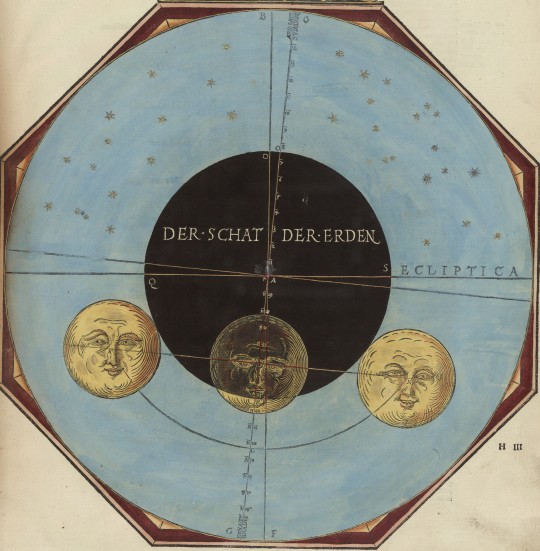
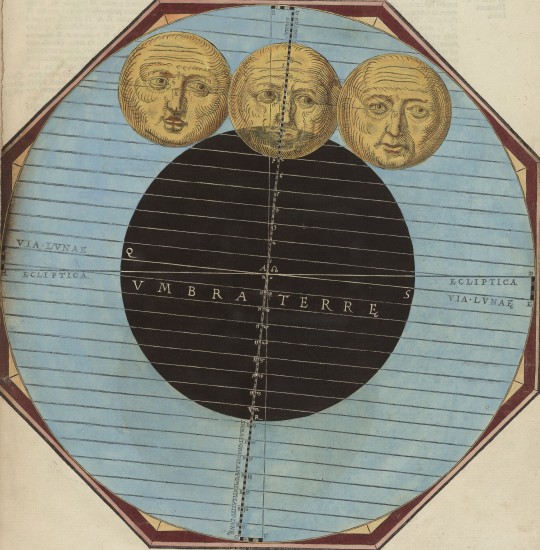
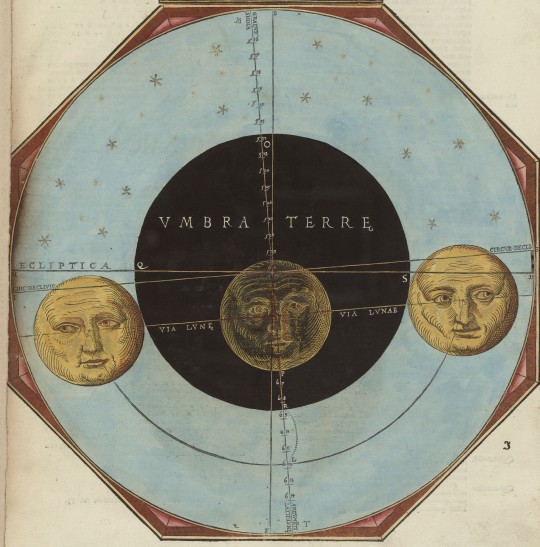
partial and total lunar eclipses
woodcuts in Petrus Apianus' "Astronomicum Caesareum", a printed astronomical book, Bavaria, 1540
source: Kassel, Universitätsbibliothek, 2° Ms. astron. 16, fol. 67r, 68r and 69r.
#for once not a manuscript#woodcuts#astronomicum caesareum#petrus apianus#lunar eclipse#historical astronomy#umbra terre#astronomy#astronomical illustrations#16th century#moon
196 notes
·
View notes
Text


Astronomicum Caesareum, Petrus Apianus [Peter Apian], 1540
#petrus apianus#peter apian#astronomicum caesareum#ancient astronomy#volvelles#astronomy books#16th century#my post#gnomonics#night sky#stargazing#astronomical instruments#dragons#wyrm#de rerum caelorum
23 notes
·
View notes
Photo
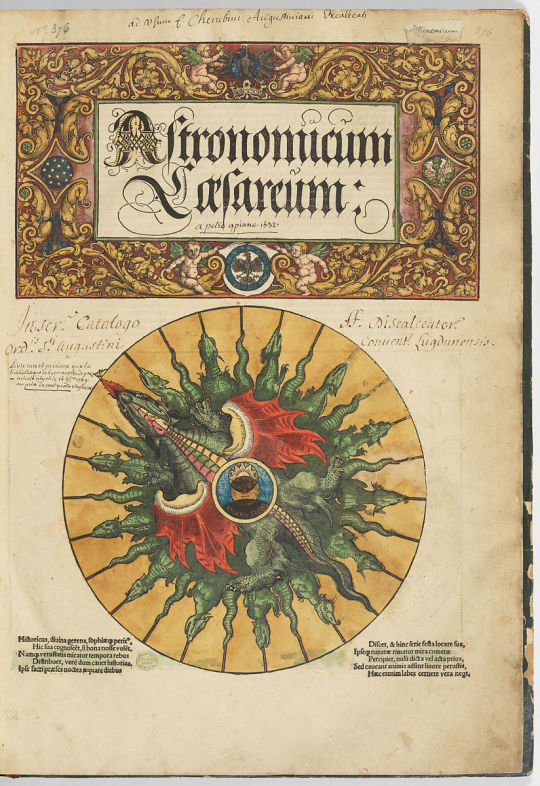
Astronomicum CaesareumMay 1540
https://www.metmuseum.org/art/collection/search/337061
Michael Ostendorfer German
Author Petrus Apianus German
Printer Georg and Petrus Apianus German
This most sumptuous of all Renaissance instructive manuals explained the use of the astrolabe (for calculating the altitude of stars) and other instruments used for computing planetary positions. The author, court astronomer to Emperor Charles V, also provided new observations on the comet of 1531 (Halley's Comet). Only about forty copies of this work survive; very few still have the seed pearls that were originally attached to the string markers on each of the eighteen disks.
Campbell Dodgson Catalogue of Early German and Flemish Woodcuts Preserved in the Department of Prints and Drawings of the British Museum. British Museum, London, 1911, cat. no. II.386.7.
F. W. H. Hollstein German Engravings, Etchings and Woodcuts, ca. 1400–1700. Amsterdam, 1954, cat. no. XXX.206.54 (1-41), p. 206.
#renaissance#astrolabe#stars#planets#emperor#discs#the age of exploration#the metropolitan museum of art
7 notes
·
View notes
Photo

.
.
.
Die Mondknoten oder Drachenpunkte sind die Schnittpunkte der Mondbahn mit der Ekliptikebene: der aufsteigende Mondknoten (übliches Symbol: ☊) ist derjenige, bei dem der Mond von der südlichen auf die nördliche Seite der Ekliptik wechselt ("aufsteigt")
Als drakonitischer Monat (drakon / δράκων: Griechisch für Drache) wird die Zeitspanne zwischen zwei aufeinander folgenden Durchgängen des Mondes durch den aufsteigenden Knoten bezeichnet.
.
.
.
Petrus Apianus' Astronomicum Caesareum
.
.
Dieselbe etymologische Bedeutung steckt in der „Ekliptik“ (griechisch ékleipsis – wörtlich „Verdeckung, Auslöschung“). Er findet sich auch in der chinesisch-konfuzianischen Mythologie bei Xi und He, 羲和, den himmlischen Beamten für Sonne und Mond. Dieser Mythos steht jedoch in keinem bekannten Zusammenhang mit dem Sternbild „Drache“.
Der drakonitische Monat dient der Berechnung von Finsterniszyklen, den regelmäßigen Wiederholungen von Sonnen- und Mondfinsternissen.
Drachenkopf (Caput draconis, aufsteigender Mondknoten)
Drachenschwanz (Cauda draconis, absteigender Mondknoten)
Vom Bild des Drachen, der bei einer Finsternis die Sonne bzw. den Mond verschluckt, leitet sich der alte Ausdruck Drachenpunkt ab (lateinisch draco „Drache“).
.
.
Nur in der Nähe eines Durchgangs des Mondes durch einen der Knoten sind Finsternisse möglich:
eine Mondfinsternis nur bei gleichzeitigem Vollmond
eine Sonnenfinsternis nur bei gleichzeitigem Neumond.
Beide Finsternistypen können sowohl am aufsteigenden als auch am absteigenden Knoten auftreten.
Das Zeitintervall zwischen zwei Durchgängen der Sonne durch denselben Mondknoten bezeichnet man als Finsternisjahr.
2 notes
·
View notes
Photo


Petrus Apianus, details from Astronomicum Caesareum - or "Astronomy of the Emperor", 1540.
662 notes
·
View notes
Photo

Petrus Apianus
“Astronomicum Caesarium”
17 notes
·
View notes
Photo
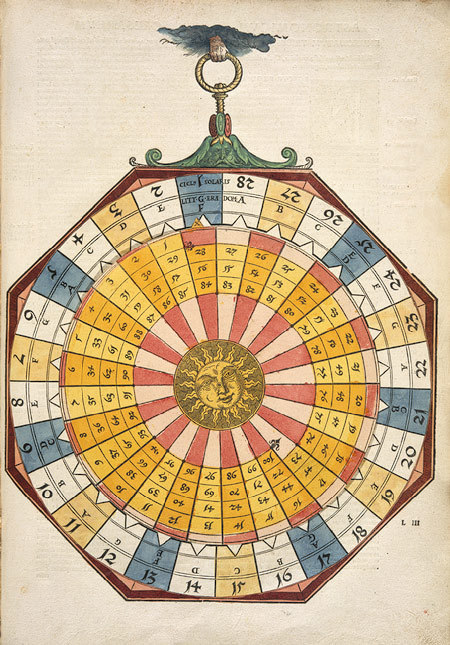

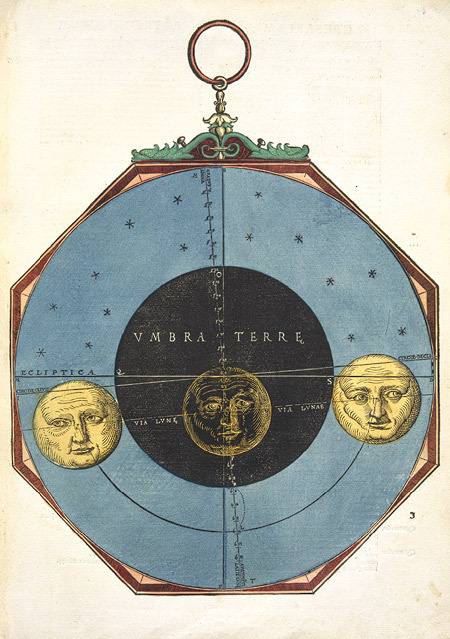

Gorgeous pages from Astronicum Caesareum, 1540, a manual on the use of astronomical devices like the astrolabe. Hand-colored woodcuts by Michael Ostendorfer, written by Petrus Apianus, court astronomer to Charles V, Holy Roman Emperor. (Metropolitan Museum of Art)
#astronomicum caesareum#space#astronomy#art#scientific illustration#16th century#1540s#petrus apianus#michael ostendorfer#holy roman emperor
88 notes
·
View notes
Photo

Petrus Apianus , Astronomicum Caesareum
105 notes
·
View notes
Photo

55 notes
·
View notes
Text
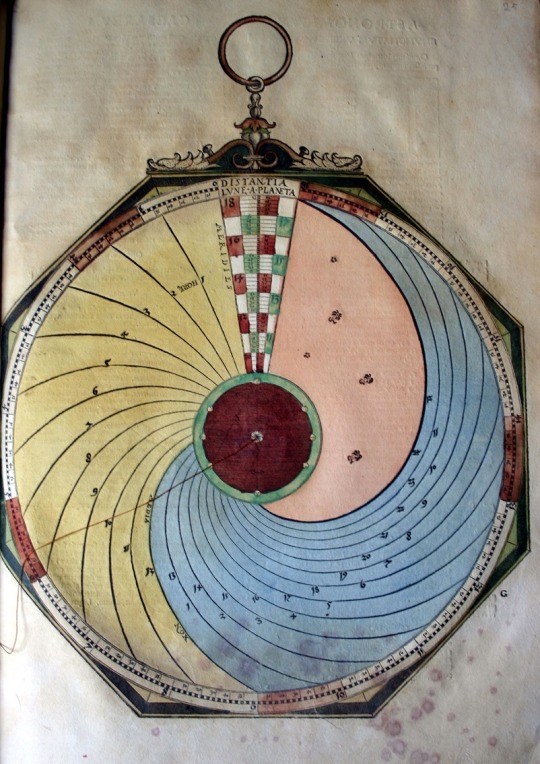
Petrus Apianus - Astronomicum Caesareum - Ingolstadt, 1540
11 notes
·
View notes
Text



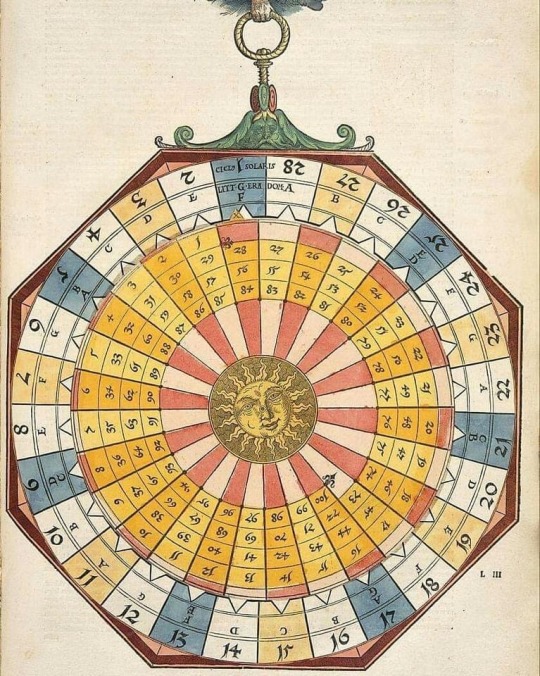



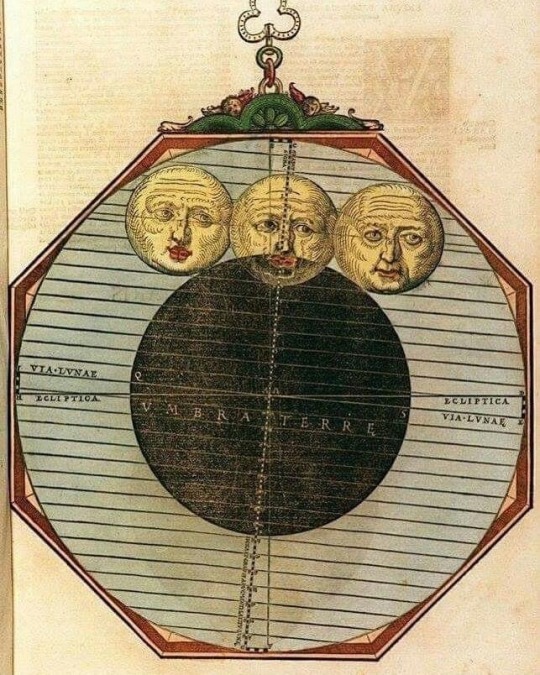
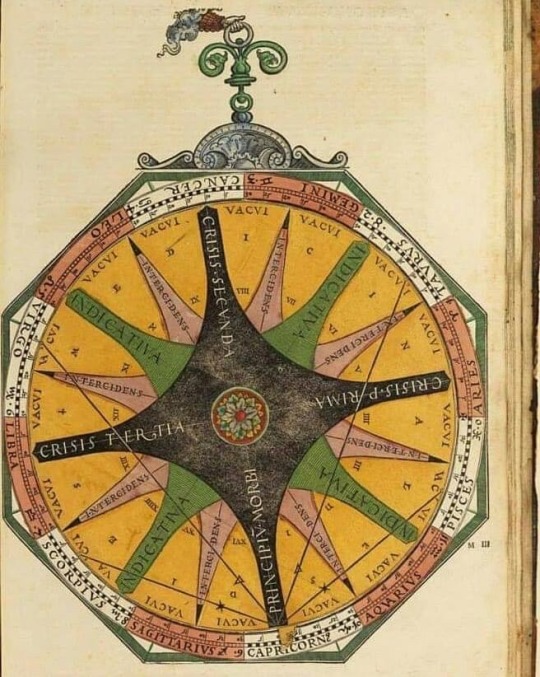
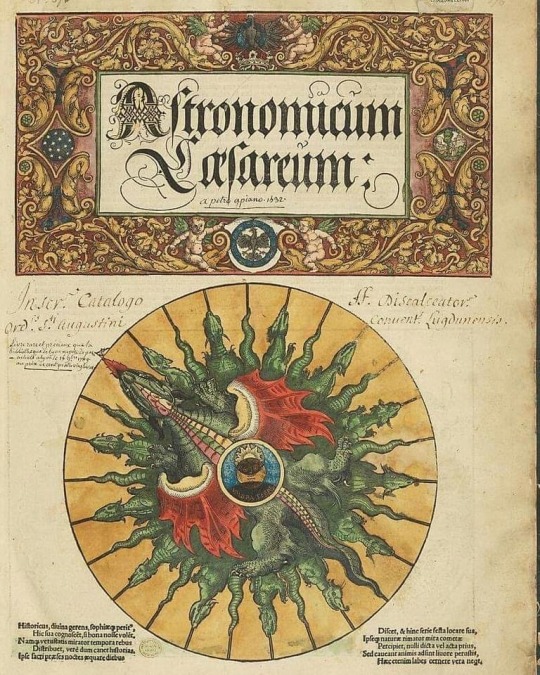
The Astronomicum Caesareum of Petrus Apianus (1540) , Artist : Michael Ostendorfer
“The “Emperor’s Astronomy” from the private press of Petrus Apianus is one of the great masterpieces of sixteenth-century printing. In this large folio volume the paper instrument found its supreme realisation in a series of intricate volvelles, all hand-colored in the astronomer’s Ingolstadt printing shop.
Before writing and crafting the Astronomicum Caesareum, Apianus had pioneered in publishing books filled with ingenious movable devices, the so-called volvelles. Half a dozen of his works were produced at his own press in the university town of Ingolstadt, where he was professor of astronomy. Production of the magnum opus must have taken the astronomer several years, for between 1534 and 1540 he published few other books. The great volume grew and changed in the course of the printing, eventually comprising fifty-five leaves, of which twenty-one contain moving parts and twelve more have index threads.”
By Stephen Ellcock
30 notes
·
View notes
Text
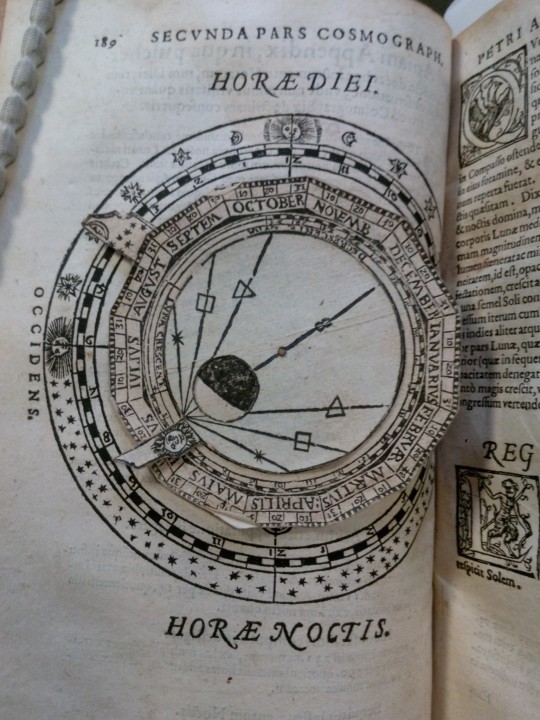




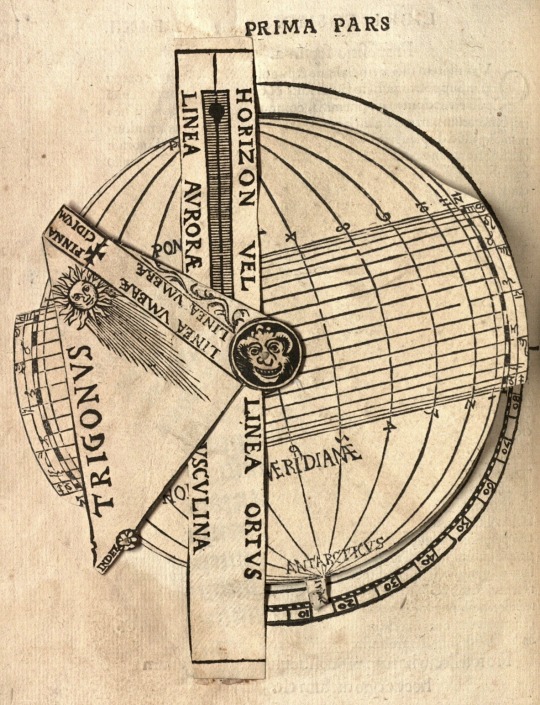
Peter Apian (Petrus Apianus), Cosmographia, 1524.
Apian developed and adapted the medieval practice of volvelles, later known also as ‘Apian wheels’, which implemented rotating parts and slide charts that were real working paper instruments. With the volvelles provided in the Cosmography, one could solve calendar problems, find the position of the sun, moon and the planets, and calculate latitude using the sun’s height above the horizon.
#paper astrolabes#gnomonics#astrolabium#astrolabe#volvelles#peter apian#cosmographia#my post#apian wheels#scientific illustration#16th century#petrus apianus#ancient astronomy#star dials#de rerum caelorum
74 notes
·
View notes
Photo

Petrus Apianus (1495 - 1552) Astronomicum Caesareum (1540) https://ift.tt/3iyjZC3 October 06, 2020 at 01:35PM
+visit our fellow Goethepunk art page
18 notes
·
View notes
Photo



Astronomicum Caesareum, Petrus Apianus, Michael Ostendorfer, Germany, 1540
Met Museum New York
Provenance: donated by Herbert N. Straus 1925
17 7/8 × 12 11/16 × 1 5/16 in. (45.4 × 32.3 × 3.3 cm)
Petrus Apianus (1495 – 1552), also known as Peter Apian, Peter Bennewitz, and Peter Bienewitz, was a German humanist, known for his works in mathematics, astronomy and cartography. His work on cosmography presented in his most famous books Astronomicum Caesareum (1540) and Cosmographicus liber (1524) were extremely influential in his time. Numerous editions in multiple languages were published until 1609.
[text source: @wikipedia]
#manuscript#16th century#museum#public domain#astronomicum caesareum#dragon#sun#moon#art#illustration#book#art history#cosmography
199 notes
·
View notes
Text
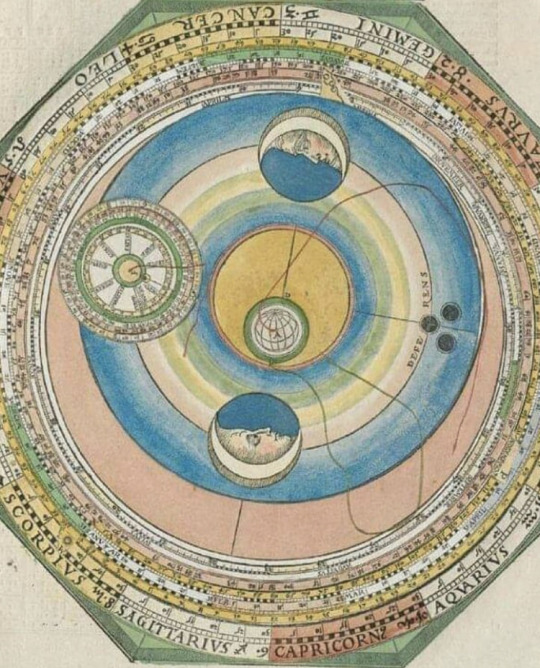
Michael Ostendorfer, The Astronomicum Caesareum of Petrus Apianus, 1540
48 notes
·
View notes
Text
Cosmographia by Petrus Apianus
This post was written by Emma-Leigh Jones, an intern from the Classics Department.
In January I had the opportunity to start a Latin/Classics internship at the Archives and Special Collections Department in Hillman Library. Over these past few weeks, I have examined and translated a few pages of three works, one of those being the Cosmographia by Petrus Apianus and Gemma Frisius. Petrus Apianus, or Peter Apian, was a German humanist who worked at the University of Ingolstadt. Although he was called there to teach mathematics, he often neglected his teaching duties to study his own works. The university didn’t mind because they just wanted him for his name and reputation. Gemma Frisius was a Dutch physician and instrument maker. He invented and improved many mathematical instruments, like Gemma’s rings, or astronomical rings.
This older edition of the Cosmographia was printed in 1553. It includes many detailed pictures and pull-out maps, and also volvelles. A volvelle is a paper wheel chart that has strings or handles that rotate it. The word volvelle comes from the Latin word volvere which means to turn. When they were first introduced, many people thought that they were the work of black magic. They believed that they had “mystical origins” and that they could predict the future. To their credit, the volvelles did “predict the future” - by means of science. Although they were more widely used in the twentieth century, the origins of volvelles can be traced back as early as the year 1000. They have been argued to be the first origins of modern technology.

One of the volvelles featured in the Cosmographia is pictured above, labelled horae diei and horae noctis, “times of day” and “times of night.” It is used to figure out the positioning of the moon and the sun during different times of the year. Unfortunately, I am unable to move any of the parts of this volvelle because the paper is very fragile and has already been broken in. However, as you can see in the picture, the dirt marks on the handles show that many other people have enjoyed turning the wheels.
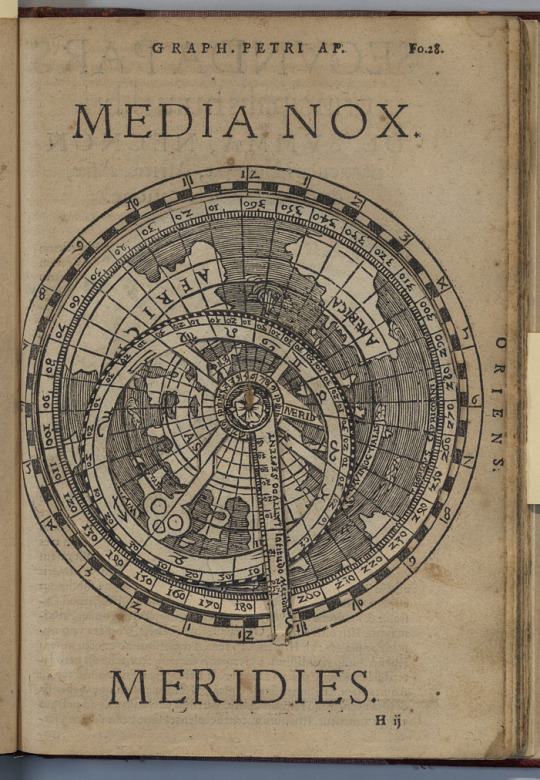
Another volvelle that is featured is this one above. From the labels, we can tell that this one was used to find the longitude of certain places. The use of a string has been implicated, and the cap in the middle with a face on it (I think it looks like a monkey, just my professional opinion) has been used to cover the knot. Covering the knot with an intricate design was a common practice in the making of volvelles.
Translations for labels:
- organum praedictas propositiones declarans: “instrument declaring predicted propositions”
- de longitudine Regionum, Provinciarum, Oppidorum, locorum’ve investiganda: “about the longitude of regions, provinces, towns, and places which are to be investigated”.
http://drc.usask.ca/projects/archbook/volvelles.php
89 notes
·
View notes